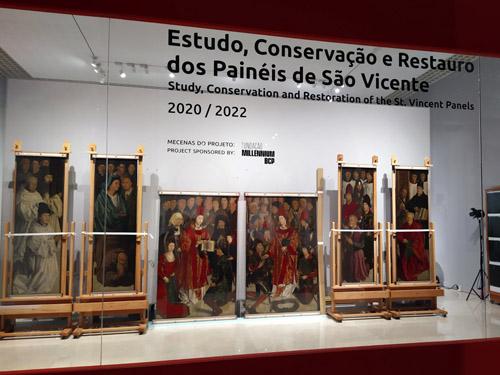As visitors look through a glass window, restorers work diligently to preserve one of Portugal’s national treasures. Paints, microscopes, X-ray machines, trays, tools, computers, frames, and tables fill the space, all set up to do this important work.

Since June 1, 2020, an international group of experts has been analyzing, scanning, and retouching one of Portugal’s most important cultural artifacts: the “St. Vincent Panels” (circa 1470). In Portuguese, the work is known as “Painéis de São Vicente.” Anyone can watch in real-time as conservation experts restore the polyptych (many-paneled painting) at the National Antique Art Museum of Lisbon, Portugal.

International Restoration Effort
The technical difficulty in restoration is to preserve the original work: to repair damage from past renovations and to uncover the original work, while not damaging the painting or giving an incorrect historic or aesthetic result.Luckily, with the latest 21st-century technology available to conservators as well as experts in other fields, the process is easier. Technical support arrived from two specialized laboratories: the HERCULES Laboratory of Évora University and the José de Figueiredo Laboratory of Lisbon, which assisted in analyzing the painting and suggesting how to best restore it using their equipment.
International consultants also arrived to help. Art historians and conservators-restorers came from The National Gallery, London, the University of Ghent in Belgium (Ghent is the city that is home to the renowned Ghent Altarpiece), the Central Institute of Restoration in Belgium, The Metropolitan Museum of Art in New York, and the Prado Museum in Madrid.

Experts first examined every inch of the six panels to record all damage done to the painting over time. This preparatory work determined the best approach to preserve the original composition and rediscover the original bright colors. After registering previous restorations completed before 2020 and any damage caused by time, the restorers began the second phase, which is now in progress.
Painstaking Progress
The experts are removing old layers of varnish to see the right chromatic range of the panels and to discover the original colors used in the painting. To see the different layers and use of colors, restorers use UV lights to register any differences in fluorescence; this allows them to recognize the different layers and use of colors.
During the UV process, experts noticed blue layers of color under red layers. The blue changed the painting entirely, as red is one of the predominant colors of the panels. Experts also saw all of the retouched areas and materials used throughout different time periods. For example, the painting was cleaned multiple times with an acid pH solution during previous restorations, which damaged some of the painting.
Earlier conservators, before the 1910 restoration, had used varnish layers that didn’t correspond to the colors originally used by the painter. The current restoration team applied varnish to parts of the panels to know which parts to clean, to see what colors were actually originally used by the painter, and what was added in later renovations.
Mysterious Collective Portrait
The panels were discovered in 1882 in the monastery of São Vicente de Fora, in the Alfama district of Lisbon. The panels were then put on display at the National Antique Art Museum, after being restored in 1910 by Portuguese painter Luciano Freire.
The panels are attributed to Nuno Gonçalves, royal painter of the court of King Afonso V. The painting—oil and tempera on oak—is thought to originally be part of the St. Vincent altarpiece in Lisbon’s cathedral, known as the Sé.
Pictorially, the painting is considered one of the first group portraits in 15th-century Europe. Collective portraits were rare during the European Renaissance, and most were not as expressive as this one. The panels are also remarkable because they are one of the few paintings that depict 15th-century Portuguese society.
To this day, there is speculation among specialists regarding the precise identities of the figures and the meaning of the panels as a whole. The artist depicted a large group of figures in this work of art. There are 58 in total gathered around St. Vincent of Saragossa, a third-century martyr and the patron saint of Lisbon. St. Vincent is pictured twice: on each of the two larger, middle panels. On either side are two narrower panels filled with more figures.

Age of Greatness

Multiple figures in the painting point to the Age of Discovery. Most importantly, the painting’s namesake, St. Vincent, who was the patron saint of seafarers during expeditions, was embraced by the Portuguese people. According to legend, the first king of Portugal, Afonso Henriques (circa 1106–1185), was said to have found the saint’s relics (remains) and brought them to Lisbon. He is not portrayed in the painting.
Another character possibly portrayed in the panels is Henry the Navigator, one of the most important figures of the early Age of Discovery. In 1895, Portuguese art historian Joaquim de Vasconcelos identified the elderly man wearing a burgundy hat on one of the central panels as Henry the Navigator. However, the identification of many of the characters, including Henry, in this polyptych is still discussed and strongly debated.
Restoring the “St. Vincent Panels” represents a chance to restore an artistic legacy to Portugal.






